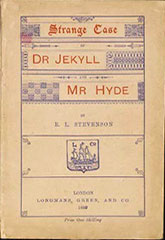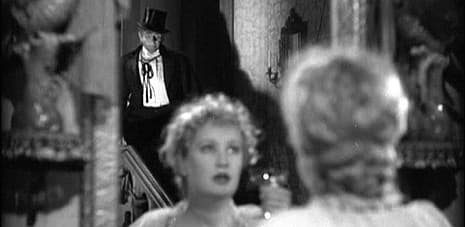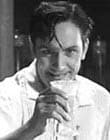Strange Case of Dr Jekyll and Mr Hyde
Critique • Quotes • Text • At the movies
 First edition
First editionFirst publication
1886
Literature form
Novella
Genres
Literary, science fiction, horror
Writing language
English
Author's country
Scotland
Length
Approx. 24,500 words

Fredric March is wickedly wolfish with the ladies as Mr. Hyde in the acclaimed 1931 film.
Holy Jesus, Dr. Jekyll
Dr. Jekyll and Mr. Hyde (1931): Film, 96 minutes; director Rouben Mamoulian; writer Samuel Hoffenstein, Percy Heath; featuring Fredric March, Miriam Hopkins, Rose Hobart
The next major adaptation takes us into the early sound era and one of the most honoured of adaptations—with a Dr. Jekyll and Mr. Hyde that expands upon the Barrymore film's storyline.
In the first few minutes Fredric March, who won an Academy Award for this performance, makes a dramatic speech in a medical lecture about the good and evil natures within each person and his attempts to separate them through chemistry—to liberate the good side. (Coincidentally, March was known before this film mainly for his stage and screen imitations of John Barrymore.)
And the doctor's good side is very good. Ridiculously so, actually. He's pretty near a Christ figure, as we're shown in scenes of him healing the sick and helping the lame to walk.
Again we follow Jekyll/Hyde almost exclusively, from his temptation by an older man to take up a life of dissipation (which he resists in saintly fashion), through his first transformations and his eventual addiction to the life of evil as Hyde.
The story is told with surprising sophistication for such an early film, with subjective camera perspectives, split screens and montages. However it ultimately collapses into a more conventional tale—a love story no less, as Jekyll's relationship with his long-waiting fiancée, the aristocratic Muriel (another character added by the Sullivan play and Barrymore film), takes centre stage. As does Hyde's brutal treatment of his bar-singing mistress, Ivy.

 March's Jekyll is too self-righteously
hammy but his Hyde is tremendous, a hairy
athletic fellow, something like a wolf man. A scarily vicious, but wickedly
clever, animal. The transformation scenes are laughable by today's
standards but state of the art for that time—better than in films a decade
or more later.
March's Jekyll is too self-righteously
hammy but his Hyde is tremendous, a hairy
athletic fellow, something like a wolf man. A scarily vicious, but wickedly
clever, animal. The transformation scenes are laughable by today's
standards but state of the art for that time—better than in films a decade
or more later.
The expanded plot takes over an hour and a half. And my, how rich everyone has gotten. The doctor, his lover, his friends—they all live in large-roomed mansions you've never seen outside of old Hollywood movies.
One thing I like though is that the protagonist is called JEE-kul, as Stevenson intended.
— Eric

